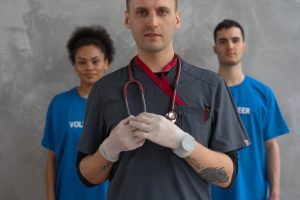Community health in Kenya has long been a critical concern for policymakers, healthcare professionals, and citizens alike. The term “community” encapsulates a diverse range of people, each facing unique health challenges. As we delve beyond the exam room, it becomes evident that a holistic approach to healthcare is essential. In this article, we explore innovative initiatives aimed at bolstering community health in Kenya, initiatives that extend beyond traditional medical practices to address the root causes of health disparities. By examining these strategies, we hope to shed light on the potential for transformative change in the overall well-being of Kenyan communities.
Empowering Communities through Education
Education stands as a critical cornerstone in the ongoing pursuit of community health, especially in regions of Kenya where access to healthcare information remains limited, fostering misconceptions and inadequate health practices. Initiatives specifically tailored to health education play a pivotal role in addressing these challenges, offering a multifaceted approach to improving community well-being. These efforts extend beyond merely imparting knowledge for preventive care; they actively empower communities to take charge of their own health.
In many parts of Kenya, the absence of comprehensive healthcare information contributes to the perpetuation of health-related misconceptions and suboptimal practices. Recognizing this gap, initiatives focusing on health education become instrumental in breaking down barriers. These initiatives utilize diverse channels, conducting workshops and seminars that cover a spectrum of topics, ranging from nutrition to hygiene. By engaging community members directly, these programs foster a culture of health literacy, equipping individuals with the tools they need to make informed decisions about their well-being.
A key strength of health education initiatives lies in their ability to empower communities actively. Beyond the mere transfer of information, these programs inspire a sense of ownership and participation in health-related matters. Workshops and seminars create spaces for dialogue, encouraging community members to share insights, ask questions, and collectively strategize for healthier living. This participatory approach is essential for fostering sustainable health practices, as communities become more than recipients of information—they become engaged advocates for their own well-being.
Community health workers, often individuals from the local populace trained in basic healthcare practices, emerge as crucial facilitators in bridging the information gap. Their intimate understanding of community dynamics, coupled with their healthcare training, positions them as trusted conduits between healthcare knowledge and the community. These workers play a vital role in not only disseminating health information but also in culturally contextualizing it, ensuring that it resonates with the community’s unique context. This cultural sensitivity makes healthcare knowledge more relevant and accessible, breaking down potential barriers arising from linguistic, cultural, or socio-economic differences.
In essence, health education initiatives in Kenya are transformative endeavors that extend beyond the mere transmission of information. They are catalysts for change, nurturing a culture of health literacy and community empowerment. By fostering active participation in well-being, these initiatives pave the way for communities to not only understand the importance of preventive care but to integrate it into their daily lives. In the pursuit of comprehensive community health, education emerges as a powerful force, illuminating a path towards a healthier, informed, and resilient populace.
Innovative Technologies: Bridging Gaps in Community Healthcare
In the digital age, technology emerges as a powerful tool in the realm of community health. Mobile health (mHealth) initiatives have gained traction, leveraging the widespread use of smartphones to disseminate health information, provide telemedicine services, and support health monitoring. These technologies bridge geographical gaps, connecting remote communities with healthcare resources. For instance, mobile apps that offer medication reminders and health tips cater to the specific needs of users, ensuring that individuals stay engaged with their health regimens. Furthermore, telemedicine consultations bring healthcare professionals virtually into the homes of those who may otherwise struggle to access medical facilities, marking a significant stride toward more inclusive and community-centric healthcare.
For instance, mobile apps that offer medication reminders and health tips cater to the specific needs of users, ensuring that individuals stay engaged with their health regimens. Furthermore, telemedicine consultations bring healthcare professionals virtually into the homes of those who may otherwise struggle to access medical facilities, marking a significant stride toward more inclusive and community-centric healthcare.
Community-Centered Healthcare Infrastructure
Building a robust healthcare infrastructure at the community level is imperative for addressing health disparities effectively. Often, communities in Kenya face challenges such as inadequate clinics, limited medical personnel, and insufficient medical supplies. Initiatives aimed at bolstering community healthcare infrastructure involve constructing well-equipped health centers, ensuring a consistent supply of essential medications, and recruiting and training healthcare professionals to serve in these areas. By decentralizing healthcare services, these initiatives not only improve access but also create a sense of ownership within the community. Residents become stakeholders in their health, fostering a collective responsibility for the well-being of all members.
Promoting Preventive Healthcare Practices
The old adage “prevention is better than cure” resonates powerfully in the context of community health, and in Kenya, where diseases like malaria and HIV/AIDS persist, initiatives focused on preventive healthcare play a pivotal role in enhancing the overall well-being of communities. Recognizing the significance of preventive measures, community health programs in Kenya actively emphasize several key aspects that collectively contribute to a healthier populace.
One primary focus of preventive healthcare initiatives is the promotion of vaccinations, a crucial tool in preventing the spread of infectious diseases. Vaccination campaigns are designed to reach communities across Kenya, ensuring that individuals are protected against preventable illnesses. By increasing vaccination coverage, these initiatives create a shield of immunity within the community, reducing the risk of outbreaks and safeguarding vulnerable populations.
Regular health check-ups are another cornerstone of preventive healthcare in Kenya. These check-ups serve as proactive measures to detect and address health issues at an early stage, preventing the escalation of potentially serious conditions. By encouraging routine health assessments, community health programs aim to instill a culture of regular monitoring, empowering individuals to take charge of their health and seek timely medical intervention when needed.
Disease screening is particularly emphasized in regions where diseases like malaria and HIV/AIDS are prevalent. Timely detection of these diseases is crucial for effective management and prevention of further transmission. Community health initiatives often facilitate screenings, ensuring that individuals have access to diagnostic services that can identify infections in their early stages. This not only allows for prompt treatment but also helps in implementing preventive measures to curb the spread of these diseases within the community.
In addition to medical interventions, preventive healthcare initiatives advocate for lifestyle changes that contribute to overall well-being. These programs encourage communities to adopt healthier diets, promoting the consumption of nutritious foods that provide essential vitamins and minerals. Regular exercise is also promoted as a fundamental aspect of a healthy lifestyle, contributing to the prevention of various chronic conditions. Simultaneously, initiatives address harmful habits, such as tobacco use and excessive alcohol consumption, advocating for their avoidance to mitigate associated health risks.
The proactive approach to health instilled by these initiatives is not only beneficial for individuals but also contributes to the broader community. By reducing the incidence of preventable diseases, these programs alleviate the burden on the healthcare system, freeing up resources for critical care and emergencies. This reallocation of resources allows for a more efficient and targeted response to health challenges within the community, ultimately leading to improved overall health outcomes.
In essence, preventive healthcare initiatives in Kenya are strategic and forward-thinking endeavors. By emphasizing vaccinations, regular health check-ups, disease screening, and lifestyle changes, these initiatives empower communities to take proactive steps toward a healthier future. In the ongoing quest for community well-being, a focus on prevention emerges as a fundamental and transformative approach, promising a healthier, more resilient, and thriving populace in Kenya.
Community Engagement and Advocacy
Engaging communities in healthcare decisions and advocating for their needs are key components of successful community health initiatives. By involving residents in the planning and implementation of healthcare programs, initiatives become more attuned to the unique challenges and cultural nuances of the community. Community leaders, influencers, and local organizations play a pivotal role in advocating for improved healthcare services and policies. Through grassroots movements and awareness campaigns, communities can voice their concerns, press for necessary changes, and actively participate in shaping their healthcare landscape. This bottom-up approach ensures that interventions are not imposed but arise organically from within the community, fostering sustainability and long-term impact.
Economic Empowerment for Healthier Communities
The nexus between economic stability and community health is undeniable. Economic empowerment initiatives aim to uplift communities by providing income-generating opportunities, vocational training, and support for small-scale entrepreneurship. When individuals can meet their basic needs, including access to nutritious food, clean water, and secure housing, the overall health of the community improves. Economic empowerment not only addresses immediate health concerns but also creates a foundation for long-term well-being. Moreover, it contributes to breaking the cycle of poverty that often intertwines with health disparities, fostering a positive trajectory for community health.
Conclusion: A Holistic Approach to Community Well-being
In conclusion, the pursuit of community health in Kenya necessitates a holistic and multifaceted approach. Beyond the exam room, initiatives centered around education, technology, infrastructure, preventive healthcare, community engagement, and economic empowerment collectively contribute to creating resilient and healthier communities. As we envision a future where every Kenyan can enjoy optimal health, it is crucial to recognize that true well-being extends beyond the absence of illness. It encompasses the empowerment of individuals and communities to actively participate in their health journey. By embracing these diverse strategies, Kenya can pave the way for a more equitable and inclusive healthcare landscape that places the community at the forefront of its own well-being.

